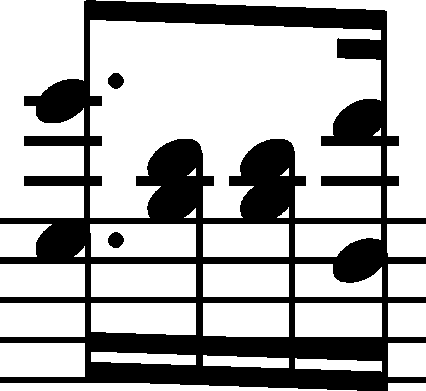



|
b. 13-15
|
composition: Op. 44, Polonaise in F♯ minor
..
In FE (→EE) the crotchet stems reach only the top notes of the R.H. octaves on the 2nd beat of b. 13 and 14; similarly, in b. 15 it is only the top notes of the octaves that are separated as the top voice on the 3rd beat (in turn, both notes of each of those octaves belong to the bottom voice). It must have resulted from a misunderstanding: Chopin's notation was misunderstood by the copyist or, which is more likely, by the engraver of FE. Chopin would always write stems on the right-hand side of noteheads, which would result in an ambiguous notation in such a situation, e.g. in b. 15: category imprint: Interpretations within context; Differences between sources issues: EE revisions , Errors in FE , Errors in GE , FE revisions |
||||||
|
b. 13-14
|
composition: Op. 44, Polonaise in F♯ minor
..
In the main text we suggest prolonging the separated R.H. octaves after the authentic notation in analogous situations in b. 37-40. We also suggest prolonging B category imprint: Editorial revisions issues: GE revisions |
||||||
|
b. 14-16
|
composition: Op. 44, Polonaise in F♯ minor
..
Without access to the manuscripts, it is difficult to say what Chopin's concept concerning the phrase marks in these bars was. A comparison of the sources leads to the conclusion that the differences probably result from the inaccurately written phrase marks in the manuscripts, hence in the main text we suggest a solution combining the most certain, according to us, elements of both versions, corresponding to a natural phrasing. category imprint: Differences between sources |
||||||
|
b. 15
|
composition: Op. 44, Polonaise in F♯ minor
..
In FE1 the top notes of the 7th and 8th R.H. semiquavers were printed a second higher (by mistake). Consequently, the 4 last octaves in this bar sound as follows when interpreted literally: d category imprint: Differences between sources issues: EE revisions , Errors in FE , FE revisions |
||||||
|
b. 15
|
composition: Op. 44, Polonaise in F♯ minor
..
All sources repeated a category imprint: Editorial revisions |

 . The fact that Chopin meant to prolong both notes of the octaves is evidenced by the dots prolonging both notes in
. The fact that Chopin meant to prolong both notes of the octaves is evidenced by the dots prolonging both notes in  in b. 13, since there is no visible reason to approach that note differently than the R.H. octave (this figure does not appear in the Polonaise in this form anymore).
in b. 13, since there is no visible reason to approach that note differently than the R.H. octave (this figure does not appear in the Polonaise in this form anymore).
 (cautionary?) before b
(cautionary?) before b